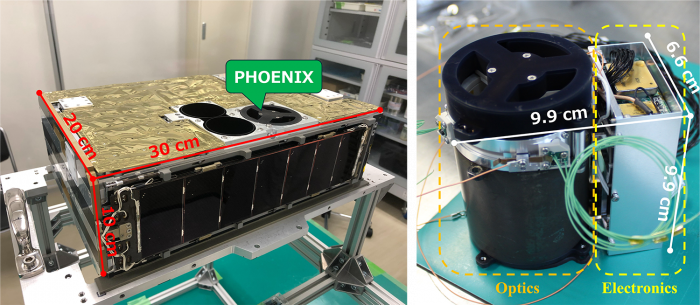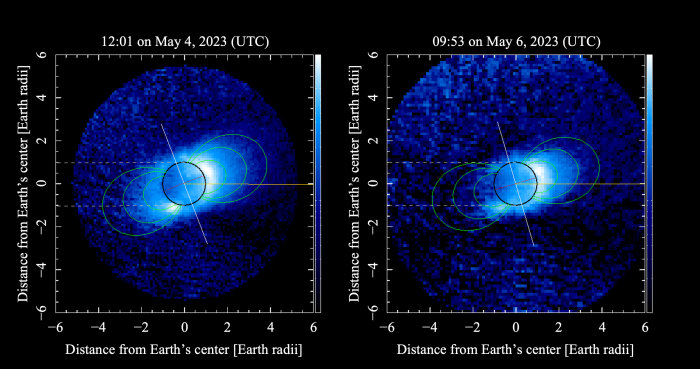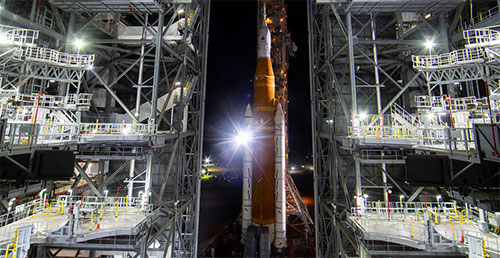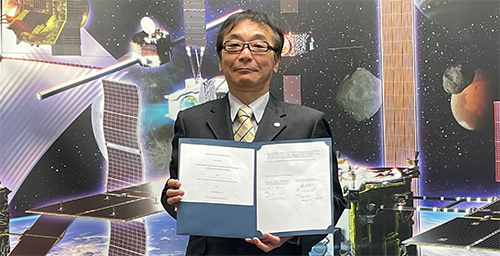The Japan Aerospace Exploration Agency (JAXA) Institute of Space and Astronautical Science (ISAS), in collaboration with Rikkyo University and the University of Tokyo (UTokyo), has successfully captured a series of images of the Earth's entire plasmasphere using the ultra-small extreme ultraviolet imager, PHOENIX, mounted on the deep space explorer, EQUULEUS.
This achievement marks an important milestone in the scientific utilization of nano and micro deep space spacecraft, and bring new possibilities to future space planetary exploration missions.
The results of this research were published in the Journal of Geophysical Research: Space Physics on April 24, 2025.
About EQUULEUS and PHONEIX
EQUULEUS is a 6U CubeSat (1U = 10cm x 10cm x 10cm) for deep space exploration that was jointly developed by JAXA and the University of Tokyo. The mission was launched onboard the NASA SLS [1] in November 2022. EQUULEUS carries the EUV imager PHOENIX, which is both ultra-small at less than 1U, and ultra-lightweight with a mass of less than 0.55kg, yet is capable of observing the emission from the plasma around the Earth with high sensitivity (Figure 1).
The PHOENIX camera is designed to observe extreme ultraviolet (EUV) radiation at a wavelength of 30.4 nm, corresponding to a specific emission line from helium ions (He) in the space surrounding the Earth (plasmasphere). Light at this wavelength is absorbed by the Earth's atmosphere, so observations must be conducted from space. The design for PHOENIX utilises a mirror with a multilayer coating to achieve high reflectivity, enabling the camera to efficiently detect weak EUV light.
Figure 1: On the left is the ultra-small deep space probe EQUULEUS (Credit: JAXA / University of Tokyo). On the right is the ultra-small extreme ultraviolet imager, PHOENIX (Credit: Modified from Kuwabara et al. 2025).
Observation results
PHOENIX successfully captured multiple global images of the Earth's plasmasphere (Figure 2) during EQUULEUS's journey to the Earth-Moon Lagrangian point [2] in May 2023. The plasmasphere is a region within the Earth's magnetosphere [3] containing a large quantity of low-energy plasma [4] that is trapped by the Earth's magnetic field.
Observations of plasmasphere to date have mainly been conducted from the north side (top side) of the Earth. Observations from above allow a view of the overall structure of the plasmasphere, but because the plasma at different altitudes and latitudes appear to overlap, the detailed density distribution is difficult to grasp. By observing the Earth's plasmasphere from the side, PHOENIX was able to clearly capture the plasma density structure along the magnetic field lines [5].
Side-on observations are suitable for revealing the three-dimensional structure of the entire plasmasphere, and allow for a detailed analysis of the plasma distribution around the Earth. In particular, it is possible to clearly identify the outer edge of the plasmasphere and its fluctuations, which are difficult to capture from the direction towards the centre of the Earth. In addition, by directly visualizing the plasma structure along the magnetic field lines, new insights have been provided to elucidate the detailed density distribution and dynamics of the plasmasphere. This has made it possible to understand the detailed three-dimensional structure of the plasmasphere, which has previously been difficult to achieve.
These observations also made it possible to confirm the contraction of the plasmasphere associated with geomagnetic disturbances [6]. This phenomenon occurs when the plasmasphere surrounding the Earth is pushed from the outside by strong winds (solar wind) and high-energy particles emanating from the Sun, causing parts of the plasmasphere to be eroded or pushed outwards. The contraction of the plasmasphere was particularly noticeable in the low-latitude regions on the night-side, which was confirmed to be consistent with past observations. Detailed analysis of the imaging data further revealed that the position of the outer edge of the plasmasphere fluctuates over time, allowing capture of the dynamics of the plasmasphere in response to changes in the magnetospheric environment.
Figure 2. Complete images of the Earth's plasmasphere observed with PHOENIX. The black circle is the Earth, the red line is the magnetic equator, the yellow line marks the direction of the Sun, the white line is the magnetic axis (upward direction is the South Pole), and the green lines are the magnetic field lines of L [7] = 2,3,4. The area surrounded by the grey dotted lines shows the shadow of the Earth. It can be seen that the plasma around the Earth is distributed along the magnetic field lines. It's also possible to see that the plasmasphere photographed on May 6 (during a geomagnetic disturbance) has shrunk compared to May 4 (when there was geomagnetic quiet). (Credit: Modified from Kuwabara et al. 2025.)
Technical achievements and future prospects
Through calibration observations using a star in orbit, PHOENIX has been demonstrated to be capable of high-precision observations, despite the small size, and has the ability to capture spatio-temporal variations in the plasmasphere.
In addition to being physically small and lightweight, nano and micro satellites and probes are characterized by the ability to be developed at low cost, and in a short period of time. These features allow a wide range of researchers to frequently conduct pioneering space science missions as their own missions, and the technological and scientific results obtained from these missions will in turn lead to larger missions such as those for medium-class projects.
The 30.4nm wavelength targeted by the PHOENIX team lies in the extreme ultraviolet region, and contains many emission lines present in planetary atmospheres and the surrounding plasma. In recent years, the efficiency of detectors and optical elements suitable for this wavelength range has rapidly advanced, and has attracted attention not only for planetary science, but also from the perspective of astrophysics. This results achieved here can be said to serve as a first step towards future large-scale missions that go beyond the boundaries of ultra-small missions.
This research shows new possibilities for observing the Earth's plasmasphere using ultra-small spacecraft. This is an important step in opening up new avenues for deep space observation using ultra-small spacecraft, which are being used by many organisations in recent years, including those in the private sector. In the future, missions such as EQUULEUS are expected to enable detailed investigation of long-term variations in the plasma environment around the Earth, and this will assist with purposes such as space weather forecasting [8].
Notes
[1] SLS (Space Launch System): The next-genration of super-large rocket being developed by NASA. Designed to return humans to the Moon and to explore Mars, the SLS has the ability to transport objects from low Earth orbit to distant planets and moons. The SLS features powerful thrust and large payload capacity, and is expected to be used for both crewed space flight and the launch of robotic probes.
[2] Lagrangian point: Five special points (L1 to L5) where the gravity and centrifugal force of two celestial bodies (in this study, the Earth and the Moon) are balanced and an object can remain stable or metastable. EQUULEUS aimed to navigate to a periodic orbit around point L2, which is on the far side of the Moon as seen from the Earth.
[3] Magnetosphere: The region formed by the Earth's magnetic field extending into space and interacting with the solar wind. Within the magnetosphere are the plasmasphere and radiation belts, which serve to protect the Earth from high-energy particles entering from space.
[4] Plasma: A special state of matter in which electrically charged particles move freely. Lightning and the aurora are examples of plasma. There is a lot of plasma in outer space near the Earth.
[5] Magnetic field lines: The Earth has properties similar to a giant magnet, and a magnetic field (the area of magnetic influence) extends around the planet. Within this magnetic field, imaginary lines that indicate the direction of magnetic force are called magnetic field lines. The Earth's magnetic field lines extend into space and play a role in guiding the movement of plasma.
[6] Geomagnetic disturbances: An abrupt change in the Earth's magnetic field from its normal state, primarily caused by energetic particles from the Sun (such as the solar wind or coronal mass ejections) interacting with the Earth's magnetic field.
[7] L (L value): In the Earth's magnetic field, this is an index that indicates the radius of the Earth (distance from the center of the Earth) at the point where the magnetic field lines cross the equatorial plane. It is expressed in units of the Earth's radius (approximately 6,400 km). For example, L=4 means that the magnetic field lines intersect the equatorial plane at a distance of four times the Earth's radius (approximately 25,600 km).
[8] Space weather forecasting: This forecast predicts changes in the space environment, such as solar wind and geomagnetic storms caused by solar activity, and assesses their impact on the Earth, artificial satellites, power grids, and communication systems. It mainly observes solar flares, coronal mass ejections, geomagnetic storms, etc., and predicts the time and scale of their impact. If severe space weather phenomena occur, it can cause satellite failures, increased GPS errors, and wireless communication disruptions, so advance vigilance is important.
Paper Information
Journal : Journal of Geophysical Research: Space Physics
Paper Title: Global and Sequential Imaging Observation of the Earth's Plasmasphere by PHOENIX Onboard EQUULEUS
Authors: Masaki Kuwabara (Rikkyo University), Kazuo Yoshioka (UTokyo), Reina Hikida (UTokyo), Go Murakami (JAXA), Ichiro Yoshikawa (UTokyo), Shintaro Nakajima (JAXA), Ryota Fuse (UTokyo), Yosuke Kawabata (UTokyo), Ryu Funase (JAXA, UTokyo)
DOI: 10.1029/2024JA033389




